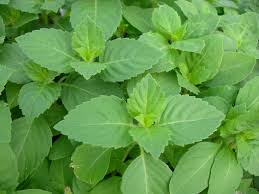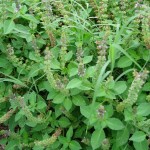By Dr. Bob McCauley
- Holy Basil Is Known As the “Elixir Of Life”

- Legendary Ability to Promote Longevity
- Radiation Removal Properties
- An Adaptogen: Strengthens the Body’s Response to Physical/Emotional Stress
- Promotes Balance and Homeostasis Throughout the Body
- Holy Basil Supports the Cardiovascular System
- Promotes Blood Stability
- Holy Basil has Healing Power
- Excellent For Digestion
- Supports the Respiratory System
- Contains Antibacterial, Antifungal Properties
- Contains Anti-Inflammatory Properties
Holy Basil is known as the “Elixir of Life” because of its legendary ability to promote  longevity. It is an adaptogen meaning it enhances the body’s natural response to physical and emotional stress, promoting balance and homeostasis in the body. Holy Basil supports the cardiovascular system and regulates insulin levels. It has healing power. It is excellent for digestion and the respiratory system. It has Antibacterial, anti-fungal, and anti-inflammatory properties.
longevity. It is an adaptogen meaning it enhances the body’s natural response to physical and emotional stress, promoting balance and homeostasis in the body. Holy Basil supports the cardiovascular system and regulates insulin levels. It has healing power. It is excellent for digestion and the respiratory system. It has Antibacterial, anti-fungal, and anti-inflammatory properties.
The advantage of combining a concentrated herb such as HOLY BASIL with a complete food such as Chlorella is that the protein allows the body to absorb and utilize the herb much more safely and effectively.
http://www.watershed.net/
 Basil is well known for removing radiation from the body. The radio-protective effects of Holy Basil are mainly attributed to the flavonoids, orientin and vicenin contained in the herb. These flavonoids have been shown to protect against radiation-induced cellular damage in human cells through increased anti-oxidant properties that include enzymes, free radical scavenging and reduced lipid peroxidation.
Basil is well known for removing radiation from the body. The radio-protective effects of Holy Basil are mainly attributed to the flavonoids, orientin and vicenin contained in the herb. These flavonoids have been shown to protect against radiation-induced cellular damage in human cells through increased anti-oxidant properties that include enzymes, free radical scavenging and reduced lipid peroxidation.
Here are some supporting studies:
Mettler, F.A., Brenner, D., Coleman, C.N., Kaminski, J.M., Kennedy, A.R., Wagner, L.K., , Can Radiation Risks to Patients Be Reduced Without Reducing Radiation Exposure? The Status of Chemical Radioprotectants. American Journal of Roentgenology, 2011.
Reshma, K., et al., Radioprotective effects of ocimum flavonoids on leukocyte oxidants and antioxidants in oral cancer. Indian Journal of Clinical Biochemistry, 2008.
antioxidants in oral cancer. Indian Journal of Clinical Biochemistry, 2008.
Ocimum sanctum L (Holy Basil or Tulsi) and its phytochemicals in the prevention and treatment of cancer. Nutr Cancer. 2013;65 Suppl 1:26-35. doi: 10.1080/01635581.2013.785010.
Devi, P.U. and A. Ganasoundari, Radioprotective effect of leaf extract of Indian medicinal plant Ocimum sanctum. Indian Journal of Experimental Biology, 1995.
Weiss, J.F., Landauer, M.R., , History and development of radiation-protective agents. Int. J. Radiat. Biol, 2009.
Uma Devi, P., et al., In vivo radioprotection by ocimum flavonoids: Survival. Radiation Research, 1999.
Singh, N., Verma, P., Pandey, B.R., Bhalla, M., Therapeutic Potential of Ocimum sanctum in Prevention and Treatment of Cancer and Exposure to Radiation: An Overview. International Journal of Pharmaceutical Sciences and Drug Research, 2012.
Uma Devi, P., K.S. Bisht, and M. Vinitha, A comparative study of radioprotection by Ocimum favonoids and synthetic aminothiol protectors in the mouse. British Journal of Radiology, 1998. 71(JULY):
 Ganasoundari, A., P. Uma Devi, and M.N.A. Rao, Protection against radiation-induced chromosome damage in mouse marrow by Ocimum sanctum. Mutation Research – Fundamental and Molecular Mechanisms of Mutagenesis, 1997.
Ganasoundari, A., P. Uma Devi, and M.N.A. Rao, Protection against radiation-induced chromosome damage in mouse marrow by Ocimum sanctum. Mutation Research – Fundamental and Molecular Mechanisms of Mutagenesis, 1997.
Nayak and P. Uma Devi, Protection of mouse bone marrow against radiation-induced chromosome damage and stem cell death by the Ocimum flavonoids orientin and vicenin. Radiation Research, 2005.
John, P., Wonder drug from tulsi extract may be your answer to cancer, in The Times of India2012: Ahmedabad.
Monga, J., et al., Antimelanoma and radioprotective activity of alcoholic aqueous extract of different species of Ocimum in C 57BL mice. Pharmaceutical Biology, 2011.
Joseph, L.J., et al., Radioprotective effect of ocimum sanctum and amifostine on the salivary gland of rats after therapeutic radioiodine exposure. Cancer Biotherapy and Radiopharmaceuticals, 2011.
Bhartiya, U.S., et al., Protective effect of Ocimum sanctum L after high-dose 131iodine exposure in mice: An in vivo study. Indian Journal of Experimental Biology, 2006.
Uma Devi, P. and A. Ganasoundari, Modulation of glutathione and antioxidant enzymes by Ocimum sanctum and its role in protection against radiation injury. Indian Journal of Experimental Biology, 1999.
Uma Devi, P., et al., Radiation protection by the Ocimum flavonoids orientin and vicenin: Mechanisms of action. Radiation Research, 2000.
Vrinda B, U.D.P., Radiation protection of human lymphocyte chromosomes in vitro by orientin and vicenin. Mutat Res, 2001.
Reshma, K., et al., Effect of ocimum flavonoids as a radioprotector on the erythrocyte antioxidants in oral cancer. Indian Journal of Clinical Biochemistry, 2005.

